Table of Contents
ToggleFactors Affecting the Cost of Horse Arena Lighting
Riding Arena Size
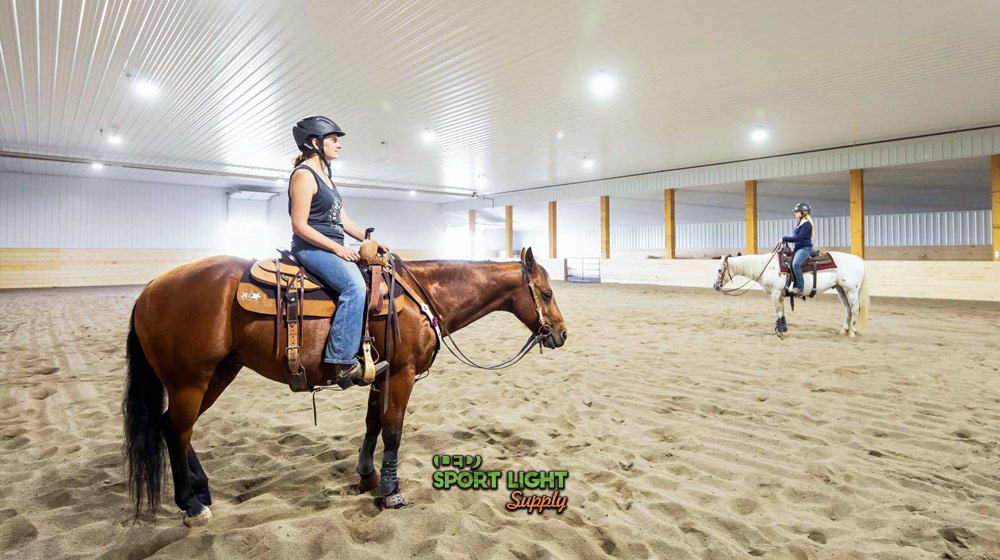
The size of the horse arena significantly impacts the cost of lighting. Larger arenas require higher lumen output to ensure adequate illumination across the entire space. This naturally leads to higher lighting costs. However, the energy efficiency of LED lights can offset these expenses, as they offer substantial savings in running costs compared to traditional lighting options. Additionally, LED lights reduce the ongoing expenses associated with lamp replacements, making them a cost-effective choice for large equestrian arenas. Arena owners must carefully evaluate these factors to manage their budget effectively.
Level of Competition
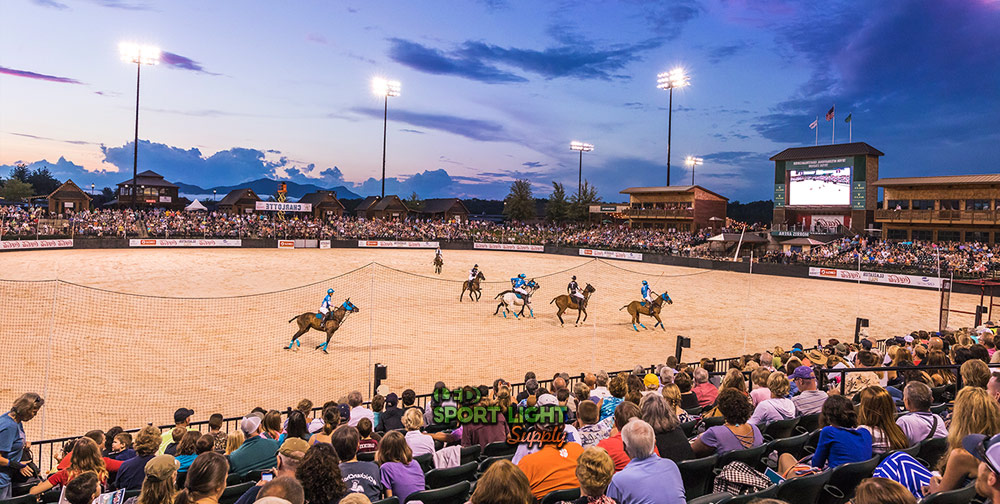
The intended use of the arena, particularly for hosting different levels of competition, affects the lighting requirements. For venues designed for semi-professional or professional equestrian events, specific lighting standards must be met. Adequate lux levels and uniformity are crucial for both the competitors and spectators, including television cameras. Proper lighting ensures that judges can accurately assess performances and that the venue maintains a professional appearance.
Lux and Lighting Uniformity Requirement
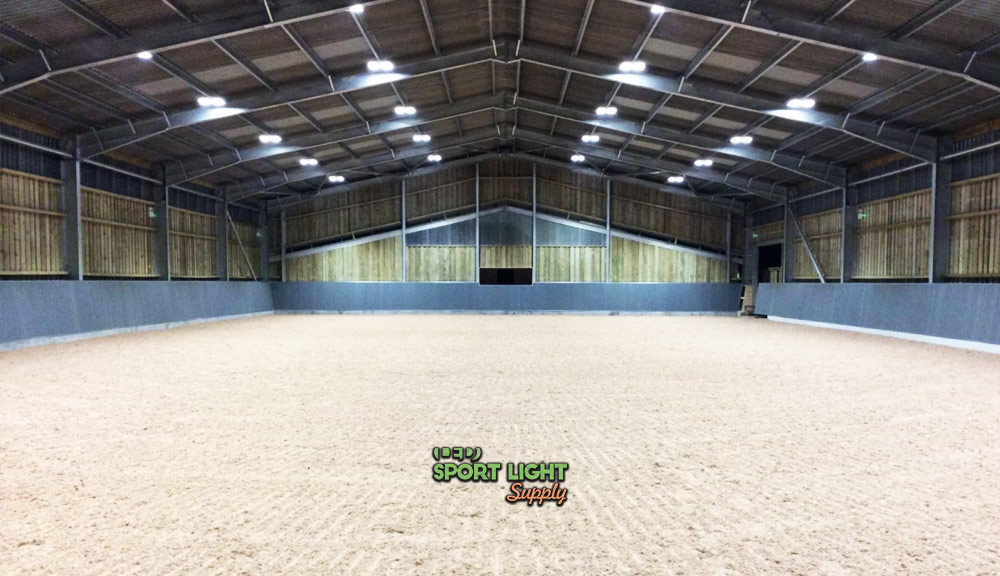
Lux levels and lighting uniformity are critical for equine events, as they impact the visibility and performance of both riders and horses. High lighting standards are necessary to facilitate public viewing and media coverage. Ensuring that the lighting conditions meet the required standards helps in presenting the event in the best possible light, whether the arena is indoor or outdoor.
Light Pole Height
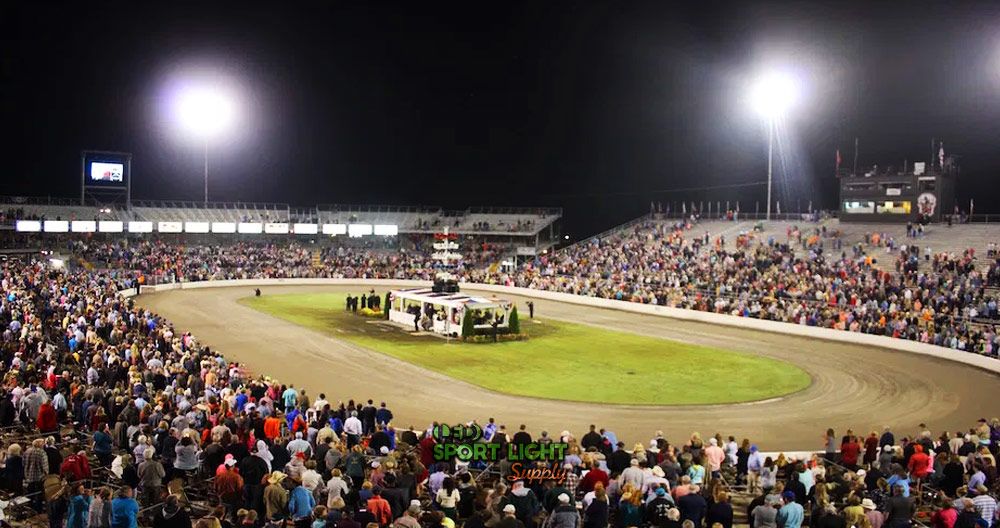
For outdoor arenas, the height of the light poles is determined by the size and shape of the arena. Taller poles are needed for larger spaces to ensure proper light distribution and uniformity. The height must also account for light loss due to distance. Proper pole height ensures that the lighting effectively covers the entire area without compromising quality.
Light Pole Layout
The number and placement of light poles are essential for optimal lighting. Typically, four poles are positioned at the corners of an outdoor arena, but larger venues may require additional poles for adequate coverage. The choice of pole height and number should be tailored to the arena’s dimensions and lighting needs to prevent any compromise in light uniformity.
Ceiling Height
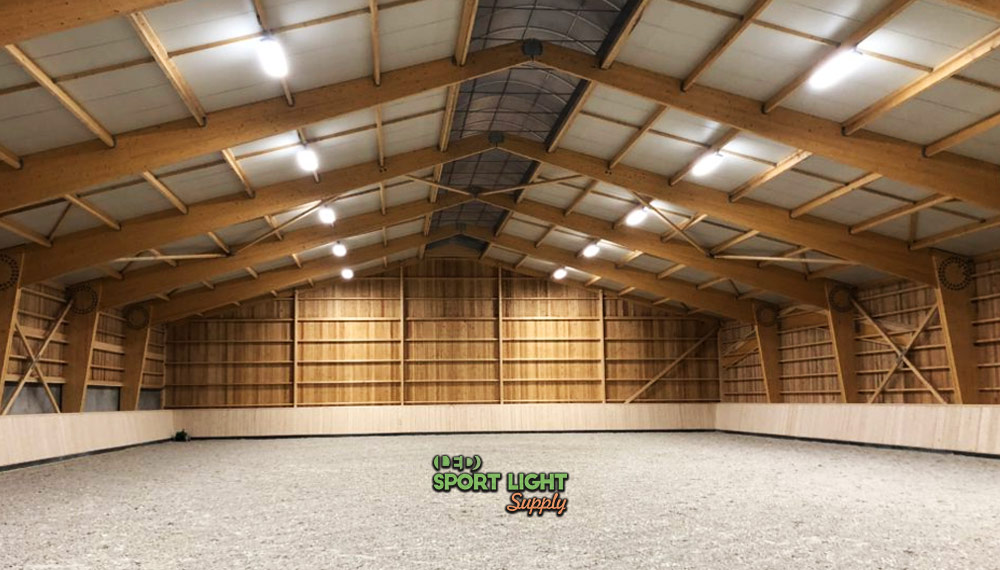
In indoor arenas, ceiling height impacts light efficiency. Higher ceilings can lead to increased light loss, so lighting designs must account for this factor. Adjustments, such as using lights with appropriate beam angles, help to minimize light wastage and ensure uniform illumination across the arena.
Light Source
LED lights, though initially more expensive, offer long-term benefits due to their longevity and energy efficiency. They typically last up to 150,000 hours, significantly reducing the cost of lamp replacements and energy consumption. In contrast, metal halide or high-pressure sodium (HPS) lights have a shorter lifespan and higher running costs, making LEDs a more economical choice for horse arenas.
Lamp Origin
The origin of light fixtures can influence their cost. Fixtures manufactured in the US may be more expensive due to higher labor and material costs. However, many US companies outsource production to remain competitive while ensuring product quality. Investing in high-quality lighting fixtures, regardless of origin, is essential for reliable performance and durability.
Outdoor vs. Indoor
Outdoor lighting fixtures must withstand various weather conditions, necessitating additional protection measures. These fixtures are generally more expensive due to their need to resist elements like rain and moisture. In contrast, indoor fixtures, such as high bay lights, do not require the same level of protection. Fixtures for outdoor use are rated with IP (Ingress Protection) ratings, such as IP65, IP66, and IP67, indicating their level of water resistance. IP67 provides the highest level of protection for environments with frequent wet conditions.
Cost of Horse Arena Lighting
Recreational Arenas
For recreational arenas requiring 200 Lux:
| Calculation | Formula | Result |
|---|---|---|
| Total Lumens | 200 Lux × 93 m² × 1.2 | 22,320 Lumens |
| Wattage | 22,320 Lumens ÷ 150 Lumens per Watt | 149 Watts |
| Operating Cost | 149 Watts × $0.6 to $1.6 | $89.40 to $238.40 |
Top-Level Competition
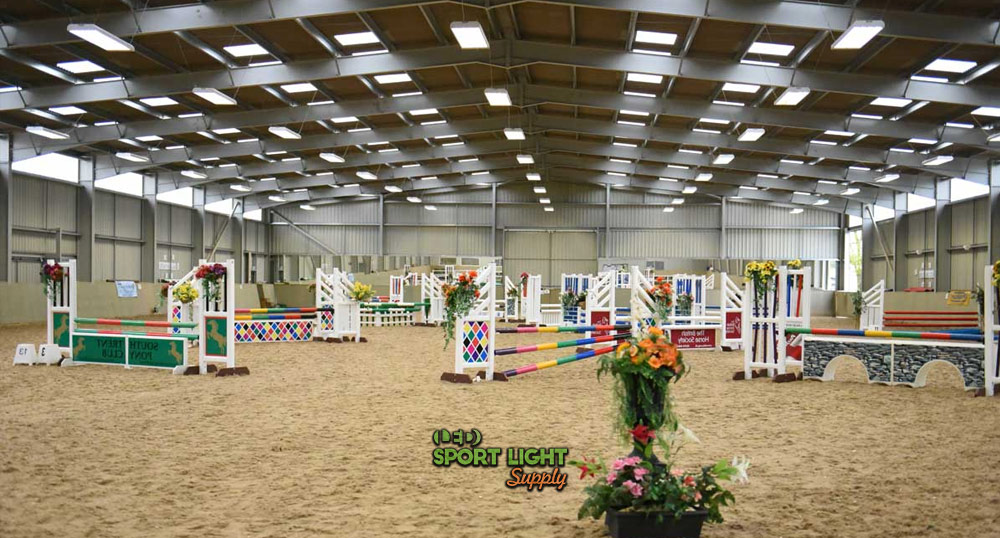
Dressage
For dressage arenas requiring 500 Lux:
| Calculation | Formula | Result |
|---|---|---|
| Total Lumens | 500 Lux × 93 m² × 1.2 | 55,620 Lumens |
| Wattage | 55,620 Lumens ÷ 150 Lumens per Watt | 371 Watts |
| Operating Cost | 371 Watts × $0.6 to $1.6 | $222.60 to $593.60 |
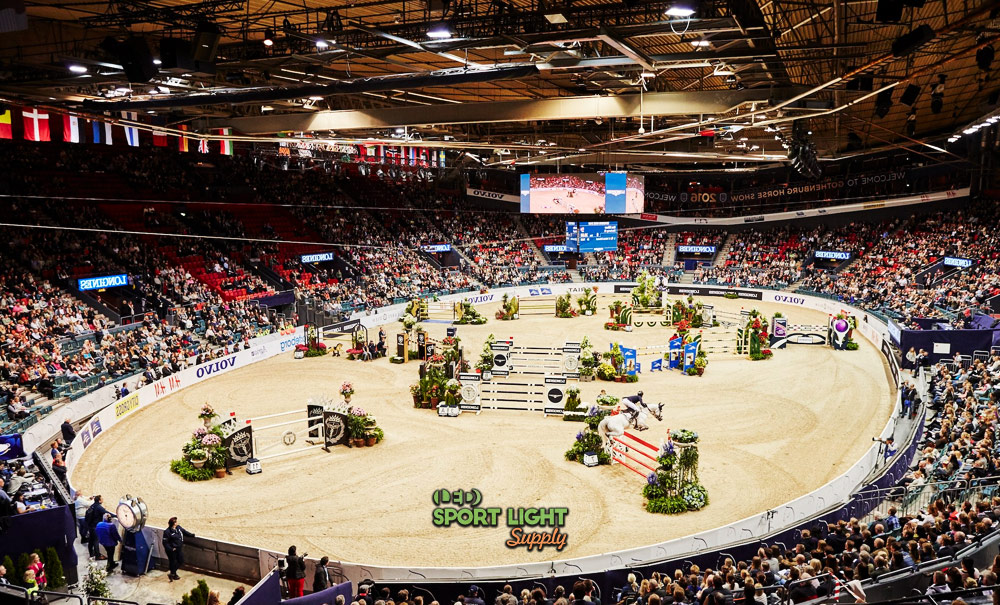
Show Jumping
For show jumping arenas requiring 700 Lux:
| Calculation | Formula | Result |
|---|---|---|
| Total Lumens | 700 Lux × 100 m² × 1.2 | 84,000 Lumens |
| Wattage | 84,000 Lumens ÷ 150 Lumens per Watt | 560 Watts |
| Operating Cost | 560 Watts × $0.6 to $1.6 | $336.00 to $896.00 |
Televised Equestrian Events
For televised events requiring 1000 Lux:
| Calculation | Formula | Result |
|---|---|---|
| Total Lumens | 1000 Lux × 93 m² × 1.2 | 111,600 Lumens |
| Wattage | 111,600 Lumens ÷ 150 Lumens per Watt | 744 Watts |
| Operating Cost | 744 Watts × $0.6 to $1.6 | $446.40 to $1,190.40 |
Power Consumption and Running Costs of LED Horse Arena Lighting
For a typical horse arena measuring 80′ by 200′ (approximately 24 x 60 meters), which totals 1,500 square meters, the lighting requirements and associated costs can be broken down as follows:
Power Consumption
| Calculation | Formula | Result |
|---|---|---|
| Total Lumens Required | 200 Lux × 1,500 m² × 1.2 | 360,000 Lumens |
| Wattage Required | 360,000 Lumens ÷ 150 Lumens per Watt | 2,400 Watts |
Running Costs
| Usage and Cost Calculation | Formula | Result |
|---|---|---|
| Daily Cost | 2,400 Watts × 6 hours × $0.1/1000 | $1.44 per day |
| Monthly Cost | $1.44 per day × 30 days | $43.20 per month |
| Annual Cost | $1.44 per day × 365 days | $518.00 per year
|
Installation Costs of Horse Arena Lighting
To estimate the installation costs for horse arena lighting, consider the following:
Cost Breakdown
| Calculation | Formula | Result |
|---|---|---|
| Cost per Fixture | Fixture Price × $0.3 to $0.8 | Varies based on fixture price |
| Total Lighting Cost for 2400 Watts | 2400 Watts × $0.6 | $1,440 |
| Installation Cost Range | $1,440 × $0.3 to $0.8 | $432.00 to $1,152.00 |
Additional Considerations
Reasonableness of Costs
The installation costs for horse arena lighting are considered quite reasonable given the scope of the work involved. The costs cover not only the physical installation of the lighting fixtures but also include the labor required to set up and ensure proper alignment and functionality. The variation in cost, ranging from $432.00 to $1,152.00, reflects differences in fixture prices and the complexity of the installation. This range ensures that the costs are kept within a reasonable budget, providing good value for the level of service and quality of installation provided.
Lighting Analysis
When electricians follow a comprehensive lighting analysis, the final installation benefits from enhanced accuracy and efficiency. This analysis includes detailed calculations and recommendations for optimal light placement and intensity, which are crucial for achieving the desired lighting levels and uniformity. By adhering to these recommendations, electricians can make precise adjustments to the setup, ensuring that the lighting meets the specific needs of the horse arena. This careful approach not only enhances the performance of the lighting system but also helps in avoiding potential issues such as uneven illumination or excessive glare, leading to a more satisfactory and effective lighting solution.
How to Save Money on Horse Arena Lights
Using LED Lights
LED lighting offers significant long-term savings despite a higher initial cost. The construction of LED lights is designed to maximize their lifespan, which translates to lower maintenance and running costs over time. Unlike traditional filament-based lighting, LEDs are more efficient and durable, resulting in reduced replacement and energy expenses. This efficiency is evident in the long-term savings as LED lights generally consume less power and have longer lifespans compared to their counterparts.
Having a Good Lighting Design
An effective lighting design is crucial for optimizing wattage usage and minimizing light spillage. A well-planned lighting design can significantly reduce light loss and improve overall illumination quality. We offer a lighting analysis service that utilizes a specialized 3D program to replicate your horse arena. This program helps us create a precise lighting diagram based on the arena’s size and square footage. By strategically positioning the lights, we ensure optimal light uniformity and efficiency, ultimately leading to cost savings and improved lighting performance.
Shorter Light Poles in a Horse Arena
For smaller horse arenas, using shorter light poles can be a cost-effective solution. While shorter poles may reduce light uniformity compared to taller ones, they can decrease overall light loss and installation costs. Our lighting analysis can provide solutions to address any potential uniformity issues, such as incorporating additional sidelights to enhance illumination. This approach helps maintain effective lighting while keeping costs down.
Using Solar Lights
Solar-powered LED fixtures offer another cost-saving option by reducing electricity expenses. The effectiveness of solar lights depends on the amount of sunlight available during the day. Sunny locations are ideal for maximizing solar energy collection, but even on cloudy days, solar panels can still generate power, though at a slower rate. Investing in solar lights can lead to substantial savings on energy costs while contributing to a more sustainable lighting solution.
Buying Lamps Before Hiring Electricians
Purchasing lighting fixtures before engaging with electricians can be a strategic way to save money. Electrical contractors may offer bundled lighting packages at a higher markup, which increases the overall cost. By acquiring the lighting fixtures and design services separately, you can avoid additional hidden costs and negotiate installation services more effectively. This approach ensures that you get the best value for your lighting investment while minimizing unnecessary expenses.
Our Conclusion
The transition to LED horse arena lighting presents a clear path to significant cost savings and improved efficiency. By opting for LED solutions, you not only benefit from lower maintenance and running costs but also achieve better lighting quality and durability. This makes LED lighting an ideal choice for managing horse expositions and other events at your private arena.
Should you have any questions or need further clarification on any aspect of LED lighting, please do not hesitate to reach out to us. We are here to assist you with any inquiries and provide additional information to help you make the best decision for your lighting needs.
